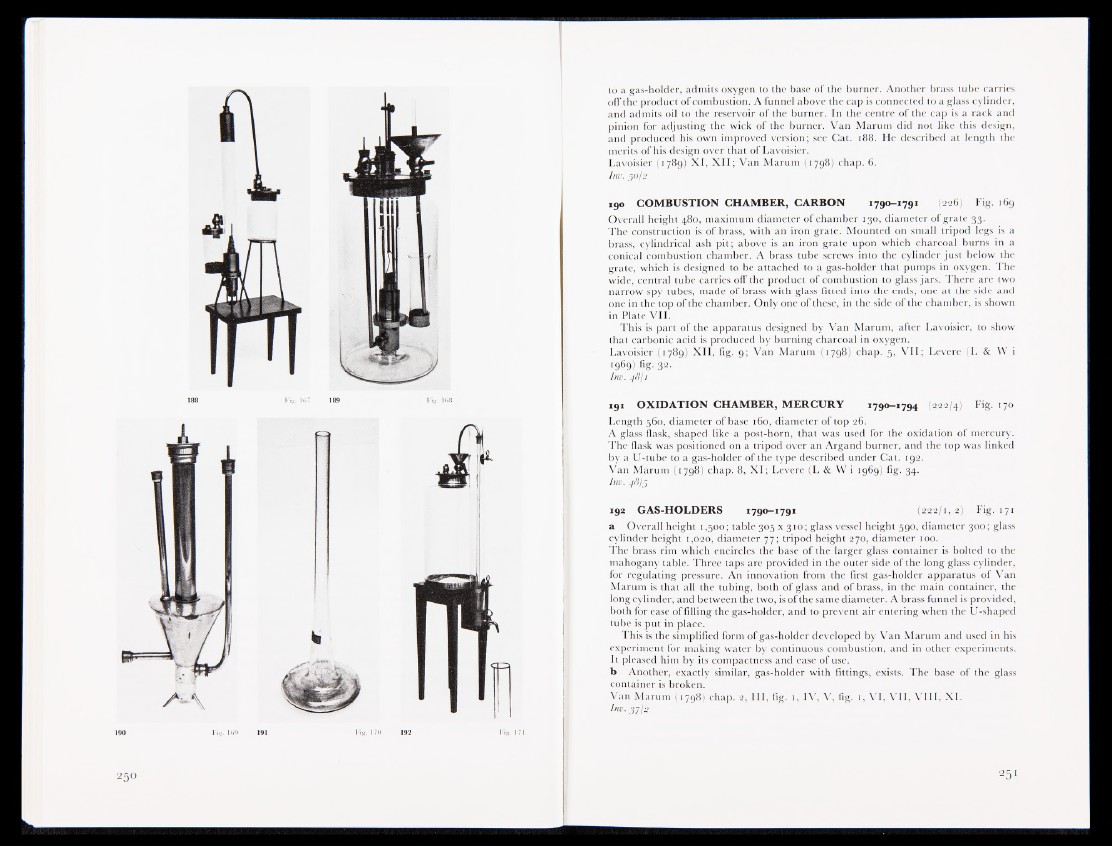
to a gas-holder, admits oxygen to the base of the burner. Another brass tube carries
off the product of combustion. A funnel above the cap is connected to a glass cylinder,
and admits oil to the reservoir of the burner. In the centre of the cap is a rack and
pinion for adjusting the wick of the burner. Van Marum did not like this design,
and produced his own improved version; see Cat. 188. He described at length the
merits of his design over that of Lavoisier.
Lavoisier (1789) XI, XII; Van Marum (1798) chap. 6.
Inv. 50/2
190 COMBUSTION CHAMBER, CARBON 1790-1791 (226) Fig. 169
Overall height 480, maximum diameter of chamber 130, diameter of grate 33.
The construction is of brass, with an iron grate. Mounted on small tripod legs is a
brass, cylindrical ash pit; above is an iron grate upon which charcoal burns in a
conical combustion chamber. A brass tube screws into the cylinder just below the
grate, which is designed to be attached to a gas-holder that pumps in oxygen. The
wide, central tube carries off the product of combustion to glass jars. There are two
narrow spy tubes, made of brass with glass fitted into the ends, one at the side and
one in the top of the chamber. Only one of these, in the side of the chamber, is shown
in Plate VII.
This is part of the apparatus designed by Van Marum, after Lavoisier, to show
that carbonic acid is produced by burning charcoal in oxygen.
Lavoisier (1789) XII, fig. 9; Van Marum (1798) chap. 5, VII; Levere (L & W i
i969) fig- 32-
Inv. 48/1
191 OXIDATION CHAMBER, MERCURY 1790-1794 (222/4) Fig. 170
Length ,560, diameter of base 160, diameter of top 26.
A glass flask, shaped like a post-horn, that was used for the oxidation of mercury.
The flask was positioned on a tripod over an Argand burner, and the top was linked
by a U-tube to a gas-holder of the type described under Cat. 192.
Van Marum (1798) chap. 8, XI; Levere (L & W i 1969) fig. 34.
Inv. 48i5
192 GAS-HOLDERS 1790—1791 (222/1, 2) Fig. 171
a Overall height 1,500; table 305 x 310; glass vessel height 590, diameter 300; glass
cylinder height 1,020, diameter 77; tripod height 270, diameter 100.
The brass rim which encircles the base of the larger glass container is bolted to the
mahogany table. Three taps are provided in the outer side of the long glass cylinder,
for regulating pressure. An innovation from the first gas-holder apparatus of Van
Marum is that all the tubing, both of glass and of brass, in the main container, the
long cylinder, and between the two, is of the same diameter. A brass funnel is provided,
both for ease of filling the gas-holder, and to prevent air entering when the U-shaped
tube is put in place.
This is the simplified form of gas-holder developed by Van Marum and used in his
experiment for making water by continuous combustion, and in other experiments.
It pleased him by its compactness and ease of use.
b Another, exactly similar, gas-holder with fittings, exists. The base of the glass
container is broken.
Van Marum (1798) chap. 2, III, fig. 1, IV, V, fig. 1, VI, VII, VIII, XI.
Inv.